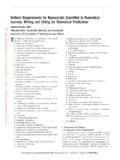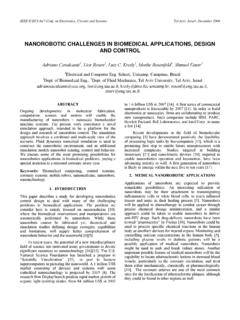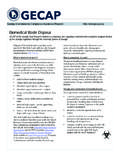Transcription of U-Net: Convolutional Networks for Biomedical Image ...
1 U-Net: Convolutional Networks for BiomedicalImage SegmentationOlaf Ronneberger, Philipp Fischer, and Thomas BroxComputer Science Department and BIOSS Centre for Biological Signalling Studies,University of Freiburg, home page: is large consent that successful training of deep net-works requires many thousand annotated training samples. In this pa-per, we present a network and training strategy that relies on the stronguse of data augmentation to use the available annotated samples moreefficiently. The architecture consists of a contracting path to capturecontext and a symmetric expanding path that enables precise localiza-tion. We show that such a network can be trained end-to-end from veryfew images and outperforms the prior best method (a sliding-windowconvolutional network ) on the ISBI challenge for segmentation of neu-ronal structures in electron microscopic stacks.
2 Using the same net-work trained on transmitted light microscopy images (phase contrastand DIC) we won the ISBI cell tracking challenge 2015 in these cate-gories by a large margin. Moreover, the network is fast. Segmentationof a 512x512 Image takes less than a second on a recent GPU. The fullimplementation (based on Caffe) and the trained Networks are availableat IntroductionIn the last two years, deep Convolutional Networks have outperformed the state ofthe art in many visual recognition tasks, [7,3]. While Convolutional networkshave already existed for a long time [8], their success was limited due to thesize of the available training sets and the size of the considered Networks .
3 Thebreakthrough by Krizhevsky et al. [7] was due to supervised training of a largenetwork with 8 layers and millions of parameters on the ImageNet dataset with1 million training images. Since then, even larger and deeper Networks have beentrained [12].The typical use of Convolutional Networks is on classification tasks, wherethe output to an Image is a single class label. However, in many visual tasks,especially in Biomedical Image processing, the desired output should includelocalization, , a class label is supposed to be assigned to each pixel. More-over, thousands of training images are usually beyond reach in Biomedical , Ciresan et al. [1] trained a network in a sliding-window setup to predictthe class label of each pixel by providing a local region (patch) around that [ ] 18 May 20152copy and cropinputimagetileoutput segmentation map6411282565121024max pool 2x2up-conv 2x2conv 3x3, ReLU572 x 572284 64128256512570 x 570568 x 568282 280 140 138 136 68 66 64 32 28 56 54 52 512104 102 100 200 30 198 196 392 x 392390 x 390388 x 388388 x 388102451225625612864128642conv 1x1 Fig.
4 Architecture (example for 32x32 pixels in the lowest resolution). Each bluebox corresponds to a multi-channel feature map. The number of channels is denotedon top of the box. The x-y-size is provided at the lower left edge of the box. Whiteboxes represent copied feature maps. The arrows denote the different input. First, this network can localize. Secondly, the training data in termsof patches is much larger than the number of training images. The resultingnetwork won the EM segmentation challenge at ISBI 2012 by a large , the strategy in Ciresan et al. [1] has two drawbacks. First, itis quite slow because the network must be run separately for each patch, andthere is a lot of redundancy due to overlapping patches.
5 Secondly, there is atrade-off between localization accuracy and the use of context. Larger patchesrequire more max-pooling layers that reduce the localization accuracy, whilesmall patches allow the network to see only little context. More recent approaches[11,4] proposed a classifier output that takes into account the features frommultiple layers. Good localization and the use of context are possible at thesame this paper, we build upon a more elegant architecture, the so-called fullyconvolutional network [9]. We modify and extend this architecture such that itworks with very few training images and yields more precise segmentations; seeFigure 1. The main idea in [9] is to supplement a usual contracting network bysuccessive layers, where pooling operators are replaced by upsampling , these layers increase the resolution of the output.
6 In order to localize, highresolution features from the contracting path are combined with the upsampled3 Fig. strategy for seamless segmentation of arbitrary large images (heresegmentation of neuronal structures in EM stacks). Prediction of the segmentation inthe yellow area, requires Image data within the blue area as input. Missing input datais extrapolated by mirroringoutput. A successive convolution layer can then learn to assemble a more preciseoutput based on this important modification in our architecture is that in the upsamplingpart we have also a large number of feature channels, which allow the networkto propagate context information to higher resolution layers. As a consequence,the expansive path is more or less symmetric to the contracting path, and yieldsa u-shaped architecture.
7 The network does not have any fully connected layersand only uses the valid part of each convolution, , the segmentation map onlycontains the pixels, for which the full context is available in the input strategy allows the seamless segmentation of arbitrarily large images by anoverlap-tile strategy (see Figure 2). To predict the pixels in the border regionof the Image , the missing context is extrapolated by mirroring the input tiling strategy is important to apply the network to large images, sinceotherwise the resolution would be limited by the GPU for our tasks there is very little training data available, we use excessivedata augmentation by applying elastic deformations to the available training im-ages.
8 This allows the network to learn invariance to such deformations, withoutthe need to see these transformations in the annotated Image corpus. This isparticularly important in Biomedical segmentation, since deformation used tobe the most common variation in tissue and realistic deformations can be simu-lated efficiently. The value of data augmentation for learning invariance has beenshown in Dosovitskiy et al. [2] in the scope of unsupervised feature challenge in many cell segmentation tasks is the separation of touch-ing objects of the same class; see Figure 3. To this end, we propose the use ofa weighted loss, where the separating background labels between touching cellsobtain a large weight in the loss resulting network is applicable to various Biomedical segmentation prob-lems.
9 In this paper, we show results on the segmentation of neuronal structuresin EM stacks (an ongoing competition started at ISBI 2012), where we out-4performed the network of Ciresan et al. [1]. Furthermore, we show results forcell segmentation in light microscopy images from the ISBI cell tracking chal-lenge 2015. Here we won with a large margin on the two most challenging 2 Dtransmitted light network ArchitectureThe network architecture is illustrated in Figure 1. It consists of a contractingpath (left side) and an expansive path (right side). The contracting path followsthe typical architecture of a Convolutional network . It consists of the repeatedapplication of two 3x3 convolutions (unpadded convolutions), each followed bya rectified linear unit (ReLU) and a 2x2 max pooling operation with stride 2for downsampling.
10 At each downsampling step we double the number of featurechannels. Every step in the expansive path consists of an upsampling of thefeature map followed by a 2x2 convolution ( up-convolution ) that halves thenumber of feature channels, a concatenation with the correspondingly croppedfeature map from the contracting path, and two 3x3 convolutions, each fol-lowed by a ReLU. The cropping is necessary due to the loss of border pixels inevery convolution. At the final layer a 1x1 convolution is used to map each 64-component feature vector to the desired number of classes. In total the networkhas 23 Convolutional allow a seamless tiling of the output segmentation map (see Figure 2), itis important to select the input tile size such that all 2x2 max-pooling operationsare applied to a layer with an even x- and TrainingThe input images and their corresponding segmentation maps are used to trainthe network with the stochastic gradient descent implementation of Caffe [6].
![arXiv:0706.3639v1 [cs.AI] 25 Jun 2007](/cache/preview/4/1/3/9/3/1/4/b/thumb-4139314b93ef86b7b4c2d05ebcc88e46.jpg)

![arXiv:1301.3781v3 [cs.CL] 7 Sep 2013](/cache/preview/4/d/5/0/4/3/4/0/thumb-4d504340120163c0bdf3f4678d8d217f.jpg)
![@google.com arXiv:1609.03499v2 [cs.SD] 19 Sep 2016](/cache/preview/c/3/4/9/4/6/9/b/thumb-c349469b499107d21e221f2ac908f8b2.jpg)












